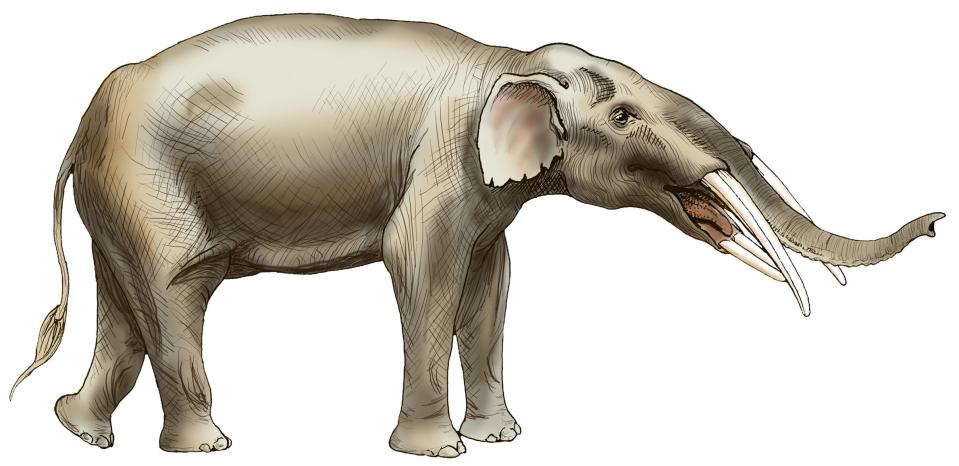'Once-in-a-lifetime': 5 million-year-old 'elephant graveyard' found in Florida
North Florida paleontologists from the Florida Museum of Natural History made a “once-in-a-lifetime” discovery when they found an elephant graveyard of an extinct relative of elephants called gomphotheres.
Jonathan Bloch, curator of vertebrate paleontology at the Florida Museum, and his team discovered parts of a gomphothere early last year at the Montbrook Fossil Dig, about 45 miles south of Gainesville.
“This is a once-in-a-lifetime find,” said Bloch. “It’s the most complete gomphothere skeleton from this time period in Florida and among the best in North America.”
Those gomphotheres likely died about five and a half million years ago, in or near a river that has long since dried up.
Isolated gomphothere bones had been found at the site before, so Bloch and his team didn’t have any reason to believe that they would find anything out of the ordinary.
Days after the gomphothere parts were found, volunteers discovered the articulated foot of something very large.
“I started coming upon one after another of toe and ankle bones,” said Dean Warner, a retired chemistry teacher and Montbrook volunteer. “As I continued to dig, what turned out to be the ulna and radius started to be uncovered. We all knew that something special had been found.”

The research team soon realized that there were several complete skeletons, including one adult and at least seven juveniles. Bloch estimated that the adult was about 8 feet tall at the shoulders. With the tusks included, the skull measured over nine feet in length.
According to Rachel Narducci, collection manager of vertebrate paleontology at the Florida Museum, it’s likely the fossils were successively deposited or transported to the area. “Modern elephants travel in herds and can be very protective of their young, but I don’t think this was a situation in which they all died at once,” she said. “It seems like members of one or multiple herds got stuck in this one spot at different times.”
Over the last seven years, paleontologists working at Montbrook have discovered the oldest deer in North America, the oldest known skull of a smilodontine sabertoothed cat and a new species of extinct heron. Fossil mainstays from the time, like bone-crushing dogs and short-faced bears, also show up scattered across the wide-brimmed fossil bed. Despite the diversity of fossils at Montbrook, most of these animals were interred after being transported by running water, and their remains are rarely found intact. The discovery of several complete gomphotheres was entirely unexpected.
What are gomphotheres
Gomphotheres are extinct relatives of modern elephants and, more distantly, mammoths. They are part of a larger group called proboscideans, which includes all modern and extinct elephant species and their close relatives, according to the Florida Museum. The group is characterized by a long trunk, or proboscis, and large tusks.
Unlike modern elephants, which have a single pair of upper tusks, many gomphothere species also had a second, smaller set of lower tusks. The form of these lower tusks varied significantly among species, with some forms splayed apart or elongated in unique ways. For instance, one genus, known as Platybelodon, had lower tusks that were flattened and broad, resembling a "shovel" shape.

Where did gomphotheres live?
Gomphotheres thrived in open savannahs, which were once common in Africa, Eurasia and the Americas. But a sustained pattern of global cooling that began about 14 million years ago led to the prominence of vast grasslands, which gradually replaced savannahs and caused gomphothere diversity to wane.
What is the Montbrook Fossil Dig?
The Montbrook Fossil Dig is the Florida Museum’s current large-scale excavation site. It’s about a 45-minute drive south of Gainesville, near Williston in Levy County.
The Florida Museum believes the site is between five and five-and-a-half million years old, between the latest Miocene and earliest Pliocene of the Hemphillian North American Land Mammal Age. It’s an ancient river system based about 30 miles inland from the Gulf of Mexico, but the area was much closer to the sea when the bones were first deposited.
More coverage from the USA TODAY Network
The sixth extinction is underway, study finds. But here's why all hope is not lost.
Mastodon skeleton discovered in New York resurfaces with historic marker.
Florida woman snaps late-night doorstep photos of alligator
These five beaches in Palm Beach County are known statewide for shark tooth hunting
Crocodile spotted (again) in Melbourne Beach, third time in 6 months
This article originally appeared on Pensacola News Journal: Gomphothere graveyard discovered in Florida near Gainesville

 Yahoo Sports
Yahoo Sports 